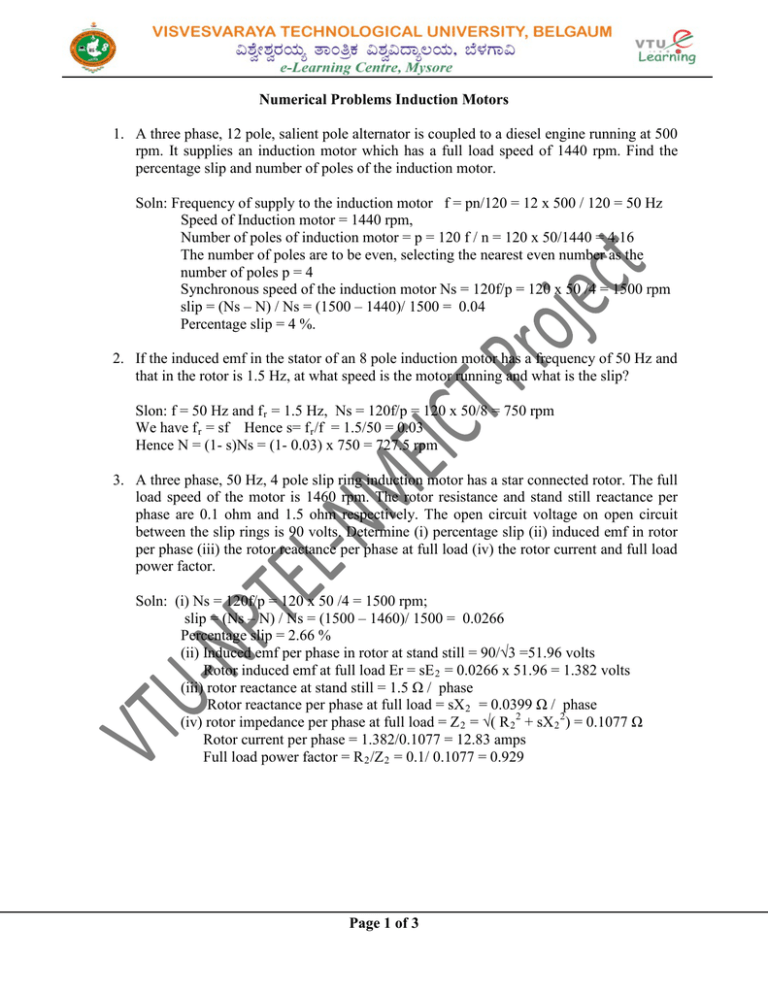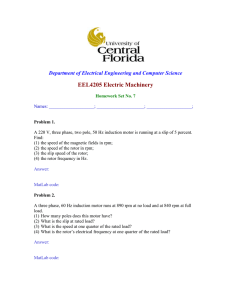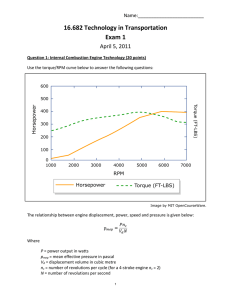Numerical Problems Induction Motors 1. A three - vtu-nptel
advertisement

Numerical Problems Induction Motors 1. A three phase, 12 pole, salient pole alternator is coupled to a diesel engine running at 500 rpm. It supplies an induction motor which has a full load speed of 1440 rpm. Find the percentage slip and number of poles of the induction motor. Soln: Frequency of supply to the induction motor f = pn/120 = 12 x 500 / 120 = 50 Hz Speed of Induction motor = 1440 rpm, Number of poles of induction motor = p = 120 f / n = 120 x 50/1440 = 4.16 The number of poles are to be even, selecting the nearest even number as the number of poles p = 4 Synchronous speed of the induction motor Ns = 120f/p = 120 x 50 /4 = 1500 rpm slip = (Ns – N) / Ns = (1500 – 1440)/ 1500 = 0.04 Percentage slip = 4 %. 2. If the induced emf in the stator of an 8 pole induction motor has a frequency of 50 Hz and that in the rotor is 1.5 Hz, at what speed is the motor running and what is the slip? Slon: f = 50 Hz and f r = 1.5 Hz, Ns = 120f/p = 120 x 50/8 = 750 rpm We have f r = sf Hence s= f r /f = 1.5/50 = 0.03 Hence N = (1- s)Ns = (1- 0.03) x 750 = 727.5 rpm 3. A three phase, 50 Hz, 4 pole slip ring induction motor has a star connected rotor. The full load speed of the motor is 1460 rpm. The rotor resistance and stand still reactance per phase are 0.1 ohm and 1.5 ohm respectively. The open circuit voltage on open circuit between the slip rings is 90 volts. Determine (i) percentage slip (ii) induced emf in rotor per phase (iii) the rotor reactance per phase at full load (iv) the rotor current and full load power factor. Soln: (i) Ns = 120f/p = 120 x 50 /4 = 1500 rpm; slip = (Ns – N) / Ns = (1500 – 1460)/ 1500 = 0.0266 Percentage slip = 2.66 % (ii) Induced emf per phase in rotor at stand still = 90/√3 =51.96 volts Rotor induced emf at full load Er = sE 2 = 0.0266 x 51.96 = 1.382 volts (iii) rotor reactance at stand still = 1.5 Ω / phase Rotor reactance per phase at full load = sX 2 = 0.0399 Ω / phase (iv) rotor impedance per phase at full load = Z 2 = √( R 2 2 + sX 2 2) = 0.1077 Ω Rotor current per phase = 1.382/0.1077 = 12.83 amps Full load power factor = R 2 /Z 2 = 0.1/ 0.1077 = 0.929 Page 1 of 3 4. A three phase slip ring induction motor has a star connected rotor. It has an induced emf of 60 volts on open circuit between the slip rings at stand still when the rated voltage is supplied to the stator. The resistance and stand still reactance of rotor per phase are 0.5 Ω and 5 Ω respectively. Determine the rotor current per phase (i) when the rotor is at stand still and connected to a star connected rheostat of resistance 5 Ω and reactance of 0.5 Ω per phase. (ii) when running at 4 % slip with rheostat short circuited. Soln: Current through rotor at stand still = current at starting As external resistance is connected in series with rotor per phase R 2 = 5.5 Ω; X 2 = 5.5 Ω (i) I 2 = E 2 / √(R 2 2 + X 2 2) I2 = (60/√ 3) / √ (5.52 + 5.52) = 4.454 amps (ii) When running at 4% slip I 2 = sE 2 / √(R 2 2 + (sX 2 )2) = (0.04 x 60/√ 3) / √ (0.52 + (0.04 x 5)2) = 2.573 amps 5. A three phase 3 kV, 24 pole, 50Hz, star connected slip ring induction motor has a rotor resistance of 0.015 Ω and a stand still reactance of 0.265 Ω per phase. Full load torque is obtained at a speed of 245 rpm. Calculate (i) ratio of maximum to full load torque. (ii) Speed at maximum torque. Neglect stator impedance. Soln: Synchronous speed Ns = 120f/p = 120 x 50/24 = 250 rpm Full load slip S f = (Ns – N) / Ns = (250 - 245)/250 = 0.02 (i) ratio of R 2 / X 2 = 0.015/0.265 = 0.0566 Ratio of full load to maximum torque (T max / T f ) = (a2 + S f 2)/2aS f = (0.05662 + 0.022)/2x0.0566x0.02 = 1.59 (ii) at maximum torque R 2 = SX 2 Hence slif at maximum torque S = R 2 / X 2 = 0.0566 Speed at maximum torque N = (1-S) Ns = 235.85 rpm 6. A 15 HP, 4 pole, 220 volts three phase star connected, 1725 rpm induction motor has the following parameters: R 1 = 0.15 Ω, R 2 = 0.18 Ω, X 1 = 0.31 Ω and X 2 = 0.31 Ω, friction and windage loss = 240 watts. Determine (i) Slip at maximum torque and maximum torque in synchronous torque (ii) slip at maximum power and maximum power (iii) starting torque and starting current. (Ans: (i) 0.282, 30700 Syn. Watts (ii) 0.204, 23400 w (iii) 17500 Syn. watts, 181 amps.) 7. No load and short circuit tests conducted on 3φ, 5 HP, 220 volts, 60 Hz, 1800 rpm induction motor gave the following results. No load test: 220 volts, 4.35 amps, 244 watts Short circuit test: Voltage of 220 volts produces a current of 64.5 Amps; Resistance per phase = 0.545 ohms, Friction, windage and core loss = 213 watts. Obtain the equivalent circuit parameters. ( Ans: X m = 29.2 Ω, Z e = 1.97 Ω, R e = 1.054 Ω, X e = 1.665 Ω, R 2 = 0.509 Ω) Page 2 of 3 8. A three phase, 50 Hz, 6 pole squirrel cage induction motor runs at 960 rpm on full load. The stand still rotor resistance and reactance per phase are 0.01 ohm and 0.05 ohm respectively. Express the maximum torque developed in terms of full load toque. Find the slip at which the maximum torque occurs. (Ans: T max = 2.6T f , 20%) 9. A water pump employs 3 phase, 50 HP induction motor which is started using a star delta starter. It is fed from feeder mains with a 3 phase, 440 volts, 50 Hz supply. Because of the drops in the feeder it is found that the starting torque is same for both star and delta connections. Calculate the resistance of the feeder. From the short circuit test on the motor the following details are obtained: V = 200 volts, I = 125 Amps, and pf = 0.4. If an identical feeder is run in parallel with the first one find the % increase in starting torque obtained with each connection. (Ans: 1.6 Ω, 37%, 119%) 10. A three phase, 50 Hz, 4 pole slip ring induction motor runs at 1455 rpm on full load. The rotor resistance per phase on stand still is 0.2 ohm. It is required to reduce the speed by 10% by inserting the series resistance in the rotor circuit. Determine the rotor resistance per phase required. (Ans: 0.6467 ohm) 11. A three phase 4 pole 50 Hz induction motor has a sinusoidaly distributed air gap flux/pole of 0.05 wb. The ratio of rotor leakage reactance to resistance under blocked rotor condition is 4. Determine the amplitude of rotor mmf required to produce a torque of 60 Nm when the motor is running at a slip of 33.33%. ( Ans: 318 AT) 12. Two induction motors are cascaded for the purpose of speed control. The main motor has 6 poles and the other motor has 4 poles. Calculate the possible speed that can be obtained if the set is run on a supply of 50 Hz frequency. (Ans: 3000 rpm, 1500 rpm, 1000 rpm & 600 rpm) 13. An 8 pole, 50 Hz slip ring induction motor runs at a slip of 2.67% on full load. The rotor resistance per phase of the winding is 0.2 ohm. What external resistance per phase must be added in the rotor circuit so that the motor now runs ate a slip of 17.33% such that the torque remains same in both the cases. (Ans: 1.1 ohm) 14. An 8 pole 50 Hz, three phase induction motor runs at a speed of 720 rpm when delivering full load torque. Its stand still rotor resistance and reactance are 0.1 ohm and 0.6 ohm per phase respectively. An additional resistance of 0.5 ohm per phase is inserted in the rotor circuit to control the speed. Calculate the speed at which the motor runs now with full load torque remaining the same. (Ans: 570 rpm) 15. A three phase induction motor designed for a rated voltage of V 1 at 50 Hz is accidentally switched on directly to a voltage of V 2 at 60 Hz. Stator impedance of the motor is negligible. Calculate the ratios of currents and torques at starting and maximum torques when V 2 = V 1 . Also find the ratio of V 2 to V 1 to obtain the same values of starting current and torque at 60 Hz. (Ans: 0.834, 0.695, 0.695, ; 1.2) Page 3 of 3

